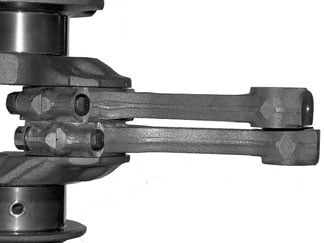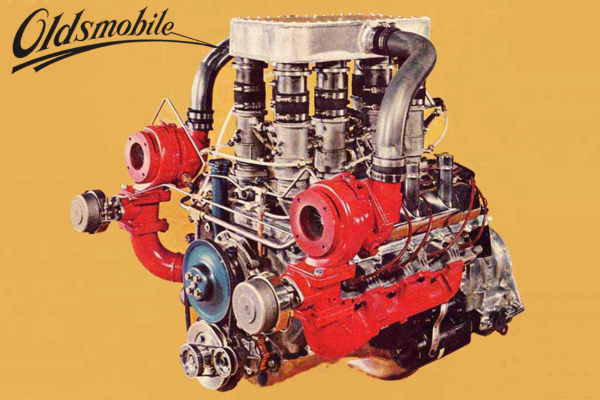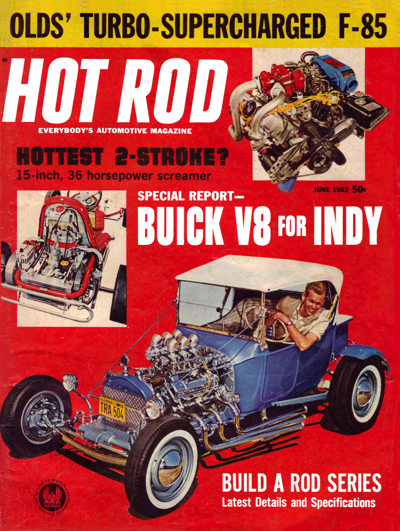Gen 3 AMC Tall-Deck V-8 (1970-1991)
Introduction
In 1970, two significant changes were made to the AMC V8 engine. All three displacement blocks had their deck height increased from 9.165″ to 9.208″ and the cylinder heads received an important redesign. These changes were major enough to consider the engine a third generation of the AMC V8, and as such, it is referred to as the GEN-3 engine.
GEN-3 AMC Tall-deck (1970-1991)
The deck height on the 290 and 343 was increased by 0.16″, to accommodate a stroke increase of the same dimension, with a resultant increase in displacement to 304 cu. in and 360 cu. in. respectively. In 1970 the AMX and other chassis using the 390 used the new block, but the displacement remained the same by using a special rod and piston in the new tall-deck block but retaining the 390 crank and its 3.574″ stroke.
Most believed that AMC kept the 390 engine size and moniker for 1970 due to the excellent reputation it had garnered in the two-seater AMX, but this seems like a huge compromise just for some marketing hoopla. After all, Chevrolet had changed the bore and stroke of the 396 to measure 400 cu. in., but they continued to call the car and the motor in the Chevelle a “396”, so there would be little need to merely keep the engine size the same merely to appease a potential buyer. In fact, in those years, everyone else was touting larger engines, so a move from 390 to 401 would have been viewed in a good light. The guess in most circles is that AMC thought that the 390 bore/stroke ratio was ideal for good horsepower and torque.
However, in the following year (and once the AMX was discontinued as a two-seater and made into a high-end Javelin) the 390 was also stroked by 0.16″ to bring the engine to 401 cu. in. Like other manufacturers, AMC realized that with the reduction in compression ratio due in September 1971, the added cubic inches would allow the recovery of the power lost from this change. It was also thought back then that longer-stroke, slower-turning engines could have their emissions controlled more easily because less radical camshafts could be used to make similar power.
The other major engineering change in 1970 was the upgrade to the famous “dog-leg” heads. These heads were proven to flow 20% better on the exhaust side than the 1966-1969 rectangle port heads. The two critical reasons for the flow increase were that the area of the port is larger, due to the dogleg and second, and the shape of the port floor was changed from a concave to a convex curve.
The concave floor had tended to bend the exhaust flow upwards which caused turbulence when the flow had to transition down into the exhaust manifolds. By switching to a convex floor, the curvature of the flow started in the head and proceeded in a much more smooth fashion into the exhaust manifold. This resulted in less turbulence and better flow.
The center two intake bolts on each head were relocated to prevent accidental mix-ups of GEN-2 and GEN-3 intakes. Even so, the intakes can be interchanged by slotting the bolt holes, but the added deck height of the GEN-3 engine means that sealing and port match will be somewhat compromised without some effort. However, GEN-2 intakes can be machined to fit GEN-3 engines by having a qualified machine shop surface grind the intake mating surface and slot the center holes.
304 V8
The 304 cu. in. was introduced in 1970 and using higher compression, produced 210 hp in 1970 and early 1971. Later models produced less power; with the 1971 and 1974 304s rated at only 150 hp, due for the most part to lesser compression and tamer camshafts (SAE rating). The 304 had a 3.75″ bore and 3.44″ stroke, with 1.787″ intake and 1.406″ exhaust valves. Larger valves are difficult to fit in the 304 because of the same valve/head interference issues as with the 290, due to the smaller cylinder bore. 360-401 heads can be fitted, but the cylinder bores may have to be notched for valve head clearance.� The 304 dog-leg heads are a good fit for the 290, however, due to their better flow characteristics.
360 V8
The 360 cu. in. V-8 came in 2 and 4-barrel carburetor configurations. The 2 bbl. produced 245 hp in 1970 and all of 71, since all were offered with low compression. The 4-barrel produced either 290 or 295 hp in that same high compression period due to the fitment of either 10.2:1 or 10.5:1 compression pistons. In 1971, the low compression (8.25:1) 4 bbl. was rated at only 285 hp. From 1972 to 1974, the 360 2 bbl. dropped to 170 hp and the 4 bbl. to 195 hp (SAE net ratings). The 360 V-8 was the last AMC V-8 to be manufactured. It was used exclusively in the Jeep Wagoneer models from 1972-84, the Cherokee from 1974 to 1983, and the Grand Wagoneer from 84 to 91.
390 V8
The AMC 390 cu. in. GEN-3�produced 325 hp in all vehicles except the Rebel Machine, which produced 340 hp due to its different intake manifold. Production of the high-deck 390 only lasted for the 1970 model year before it was stroked 0.16″ to become the 401. As its GEN-2 cousin, the maximum factory recommended overbore for 390s is only 0.020″, though they are commonly bored 0.030″.
401 V8
The 401 cu. in. produced 335 hp in early 1971, 330 hp in late 1971. In 1972-74 the rating dropped to 255 hp SAE net with the “Go Package” (dual exhausts) and 235 hp with a single pipe. The 401’s last iteration was when it was used exclusively in full-size Jeeps from 1977 to 1979, the last production year. Like the 390, the 401’s crankshaft and connecting rods are forged steel. And as in the 390, the factory recommended overbore is only 0.020″, though they can commonly be bored to 0.030″.
AMC Gen 3 Engine Specs
| Gen-3 Blocks Deck Height = 9.208" | Year | Engine Cu. In. Carb Type | Horsepower @ RPM | ft.lbs. Torque @ RPM | Comp. Ratio | Bore Stroke | Intake Valve | Exhaust Valve |
| 1970 | 304-2B | 210 @ 4400 | 305 @ 2800 | 9.0:1 | 3.750" x 3.440" | 1.792" | 1.411" | |
| 360-2B | 245 @ 4400 | 365 @ 2600 | 8.5:1 | 4.080" x 3.440" | 2.030" | 1.685" | ||
| 360-4B (Early) | 290 @ 4800 | 390 @ 3000 | 10.2:1 | 4.080" x 3.440" | 2.030" | 1.685" | ||
| 360-4B (Early) | 295 @ 4800 | 395 @ 3000 | 10.5:1 | 4.080" x 3.440" | 2.030" | 1.685" | ||
| 390-4B | 325 @ 5000 | 420 @ 3200 | 10.2:1 | 4.165" x 3.574" | 2.030" | 1.685" | ||
| 390-4B (Machine) | 340 @ 5000 | 427 @ 3600 | 10.2:1 | 4.165" x 3.574" | 2.030" | 1.685" | ||
| 1971 | 304-2B | 210 @ 4400 | 300 @ 2600 | 8.4:1 | 3.750" x 3.440" | 1.792" | 1.411" | |
| 360-2B | 235 @ 4400 | 365 @ 2600 | 8.5:1 | 4.080" x 3.440" | 2.030" | 1.685" | ||
| 360-4B (Early) | 295 @ 4800 | 395 @ 3000 | 10.5:1 | 4.080" x 3.440" | 2.030" | 1.685" | ||
| 360-4B (Late) | 285 @ 4800 | 385 @ 3000 | 9.5:1 | 4.080" x 3.440" | 2.030" | 1.685" | ||
| 401-4B (Early) | 335 @ 5000 | 435 @ 3400 | 10.2:1 | 4.165" x 3.574" | 2.030" | 1.685" | ||
| 401-4B (Late) | 330 @ 5000 | 430 @ 3400 | 9.5:1 | 4.165" x 3.574" | 2.030" | 1.685" | ||
| 1972 | 304-2B | 150 @ 4200 | 245 @ 2500 | 8.4:1 | 3.750" x 3.440" | 1.792" | 1.411" | |
| 360-2B | 170 @ 4400 | 285 @ 2400 | 8.25:1 | 4.080" x 3.440" | 2.030" | 1.685" | ||
| 360-4B | 195 @ 4400 | 295 @ 2400 | 8.25:1 | 4.080" x 3.440" | 2.030" | 1.685" | ||
| 360-4B (Dual Ex) | 220 @ 4400 | 315 @ 3100 | 8.25:1 | 4.080" x 3.440" | 2.030" | 1.685" | ||
| 401-4B | 235 @ 4600 | 325 @ 2400 | 8.25:1 | 4.165" x 3.574" | 2.030" | 1.685" | ||
| 401-4B (Dual Ex) | 255 @ 4600 | 345 @ 3300 | 8.25:1 | 4.165" x 3.574" | 2.030" | 1.685" | ||
| 1973 | 304-2B | 150 @ 4200 | 245 @ 2500 | 8.4:1 | 3.750" x 3.440" | 1.792" | 1.411" | |
| 360-2B | 170 @ 4400 | 285 @ 2400 | 8.25:1 | 4.080" x 3.440" | 2.030" | 1.685" | ||
| 360-4B | 195 @ 4400 | 295 @ 2400 | 8.25:1 | 4.080" x 3.440" | 2.030" | 1.685" | ||
| 360-4B (Dual Ex) | 220 @ 4400 | 315 @ 3100 | 8.25:1 | 4.080" x 3.440" | 2.030" | 1.685" | ||
| 401-4B | 235 @ 4600 | 325 @ 2400 | 8.25:1 | 4.165" x 3.574" | 2.030" | 1.685" | ||
| 401-4B (Dual Ex) | 255 @ 4600 | 345 @ 3300 | 8.25:1 | 4.165" x 3.574" | 2.030" | 1.685" | ||
| 1974 | 304-2B | 150 @ 4200 | 245 @ 2500 | 8.4:1 | 3.750" x 3.440" | 1.792" | 1.411" | |
| 360-2B | 170 @ 4400 | 285 @ 2400 | 8.25:1 | 4.080" x 3.440" | 2.030" | 1.685" | ||
| 360-4B | 195 @ 4400 | 295 @ 2400 | 8.25:1 | 4.080" x 3.440" | 2.030" | 1.685" | ||
| 360-4B (Dual Ex) | 220 @ 4400 | 315 @ 3100 | 8.25:1 | 4.080" x 3.440" | 2.030" | 1.685" | ||
| 401-4B | 235 @ 4600 | 325 @ 2400 | 8.25:1 | 4.165" x 3.574" | 2.030" | 1.685" | ||
| 401-4B (Dual Ex) | 255 @ 4600 | 345 @ 3300 | 8.25:1 | 4.165" x 3.574" | 2.030" | 1.685" |






